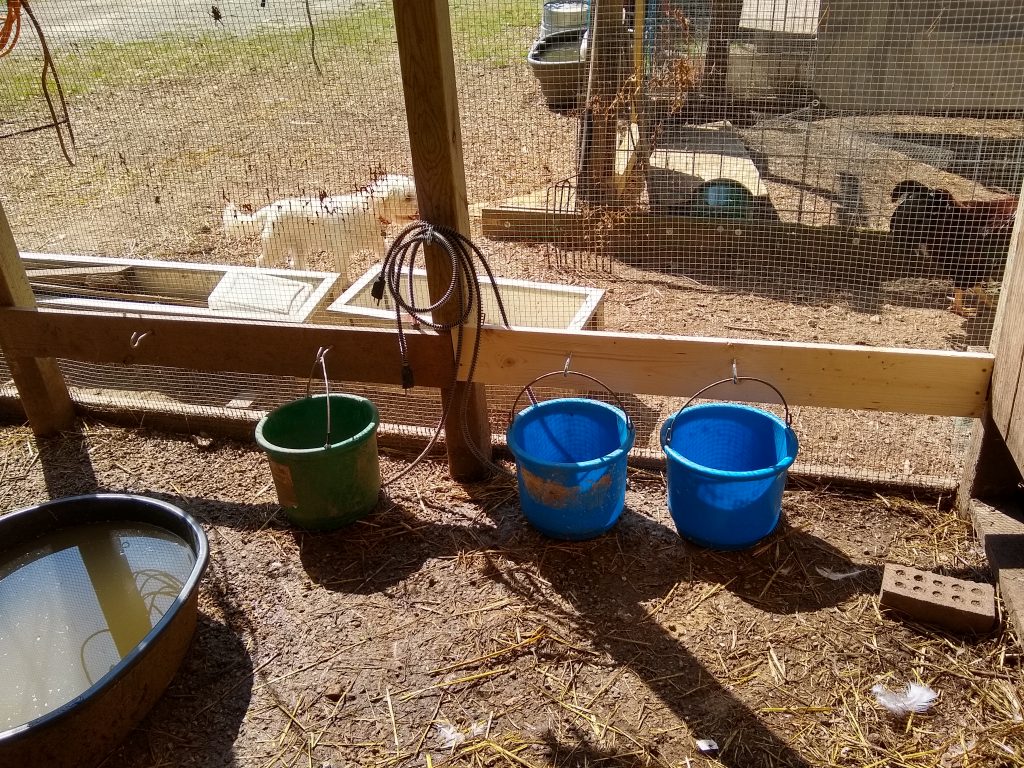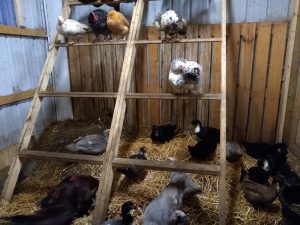Winterizing Your Poultry...Some surprises
How the BestHomestead Handles Winter
There are 3 main concerns for protecting our winter poultry: staying out of the wind, staying dry, and getting water that isn’t frozen. Note that I did not say ‘staying warm’, because this isn’t a concern in most areas of Michigan and even in most areas of the country. Poultry have built in winter coats that are more than adequate for winter warmth because feathers are one of nature’s best insulators. Think ‘down coats.’
Because of feathers, all poultry really need as a shelter is a way to get out of certain hostile elements-like wind and rain.
Blowing wind is one enemy of insulating feathers because it lifts them away from the bird’s body and releases the heat that has been stored underneath. A bird in blowing wind can therefore die of hypothermia. A bird in low temperatures inside of any kind of shelter that protects it from the wind is toasty indeed. As proof, birds in the wild survive by taking advantage of thick brush, sides of trees, or frankly, any windbreak that works.
Of course, the other enemy of insulating feathers is dampness or actual wetness. Feathers lose their ability to insulate if the smaller elements of each individual feather are unable to spread out, interlock and hold air. This happens with too high humidity or if the bird gets wet. So a tightly locked shelter that gets full of humidity is not helping your birds. In fact, this will make your birds work harder to stay warm. For this reason, our poultry prefer a shelter that has plenty of ventilation to remove excess humidity. Also, that same humidity can be like dew on a window and evaporate on a bird’s tender comb, wattles or other skin. This is how your birds may get frostbite-too much humidity. Of course, a bird that gets actually wet is in danger of immediate hypothermia because wet feathers are not insulating at all, and in fact, are heat-wicking, or literally drawing heat out of the bird.
Using the principles outlined above, your ideal shelter is simply a good windbreak with good ventilation. It is NOT an airtight building with a heat source, or in other words–something similar to your home. Your poultry will hate this kind of shelter and will escape at every opportunity if they can.
Here on the BestHomestead, we winterize by providing a well ventilated, wind-protected coop building. We don’t provide heat because it isn’t necessary. In fact, our birds have the opportunity to roost outside of the coop proper and most of the time choose to do this. This is where they are most comfortable. That should be telling.
Also, heat lamps over straw in the winter are a serious fire risk. I have seen, or rather pics of, and heard of, several coops that went up in flames from heat lamp use.
The other major problem of winter for poultry is providing water. I should say this is a headache, because in places as cold as Michigan, it is. It took me quite a while to figure this one out because there are many options. Some of them good. Some of them not so good.
The problem is that the owner must not only haul the water out to the birds, but also pour out the used water somewhere that does not increase the humidity of the enclosure, nor turn the bedding into a wet, disgusting, anaerobic mess. I’ve discovered that most hoses are useless in the cold of a Michigan winter because even if I could get the water out to the birds before freezing, the hose would inevitably freeze afterward. No matter how much I tried to drain the hose, it still froze too much to be useful. I found it impossible to buy a heated hose long enough to reach my coops and they are not supposed to be run concurrently in-line.
I tried putting a horse trough heater in a small trough but then filling this was a problem without a heated hose and emptying caused a mess. Heated waterers didn’t seem to work out here either, they were too heavy, too cumbersome to work in the cold with freezing fingers and too difficult to clean. Also, the ducks couldn’t dip their heads into the water like they needed to.
What worked out best for us was to utilize several 20 gallon heated buckets. My maximum for lifting is about 20 gallons, or 20 lbs, so I simply filled several buckets daily and hauled these out on a wagon daily. This situation was still a bit cumbersome, but do-able. I hooked these buckets up to several extension cords in the garage and to some outlets in the coop. I emptied these outside the coop area by simply pouring the water in that direction. They were deep enough for the ducks to dunk their heads into and for the chickens and turkeys to drink from. If they needed cleaning, it was an easy swish with some extra water. In short, they were quick, easy, and they worked-the water didn’t freeze.
When I get tired of hauling water in the deep freeze, usually mid-December through February, I put all the birds in the barn and use a heated potable hose meant for camping to fill several of those heated buckets. All I do is pour the old water out a door then fill with new water. With electricity in the barn and a frost-free hydrant already set up, it’s all very easy.
As far as number of buckets a poultry owner might need, Chickens drink much less water during the winter so 1-20 gallon bucket per 8 chickens is adequate. For ducks, who need to dunk their heads into water to be healthy and like to play with their water, 1-20 gallon bucket for every 3 ducks will probably suffice. I stick to 20 gallon buckets because they are easier to work with and fill, but there are bigger buckets available. Also, I make sure to hang each one just off the floor, which is enough so that weight of the water in the bucket will keep it from tipping over, otherwise they will surely be knocked over by exuberant birds and create a frozen mess.
I usually buy the buckets meant for horses or other farm animals. Also, I prefer the buckets that have a ‘indent’ in the middle of the handle, as these hang better and are less likely to tip to one side when filled and thus spill. I have found that the buckets only last 1-2 seasons, so plan accordingly.
We also employ the deep litter method as much as possible, so during the winter this provides some warmth and live food. I’ve noticed that many owners are confused about what this method really is, so in future posts we will discuss the science of deep litter.
If one has no electricity available there are a few alternatives that a poultry owner might try. Some have put ping pong balls in their water. The movement of the balls will work to keep the water from freezing until the temperatures really drop. How low that temperature actually is depends on your individual conditions.
Others without electricity simply have several buckets on hand and swap out the old frozen bucket for a new fresh one. The downside is that this requires more buckets and lots of hauling back and forth of heavy buckets.
If the poultry owner has electricity some distance away, one can run a 100 to 200 ft. extension cord for the water source. This extension cord can be protected from the elements by placing the connection inside of a plastic container and wrapping openings with electrical tape.
Please share your winter strategies, what works and what hasn’t for your poultry.





